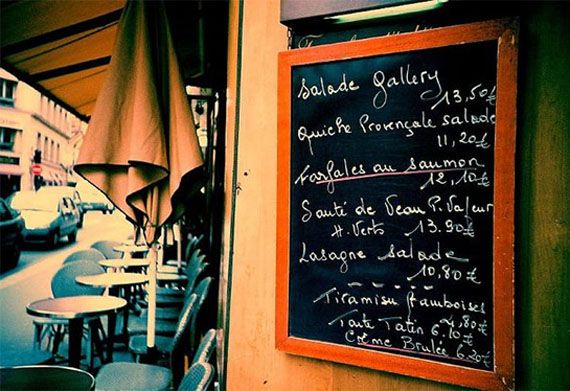
Photo Courtesy of Flickr/theCarol
Regardless of how adventurous or curious an eater you are, disembarking in France with little to no knowledge of the language can often mean eating something you really didn’t think you’d ordered.
Navigating the nuances of a menu, assuming you’re an intrepid traveler who avoids the tourist traps with translated versions, can be a real challenge. More than just a matter of knowing that poulet means chicken or that there is actually no such thing as "marinara sauce" in Italy, reading a foreign menu is a matter of semantics.
Hamburger may be a universal language, especially in France, but toppings, sides, and doneness of meat are all important factors in your enjoyment. Same goes for your pizza in Italy. You may enjoy a spicy pepperoni stateside, but order pepperoni on your pie in Italy and you’ll be surprised to find a helping of bell peppers — peperoni in Italian. Those slices of meat you were looking for are called salame.
Even asking to take a look at the menu can get you in some multi-coursed hot water — a menu in many European countries is a prix-fixe menu whereas the à la carte options are usually found on a carte, carta, or speisekarte. Perusing the carte, in France, you’ll notice the entrées at the top where our appetizers usually appear. They are one and the same across the pond — the word entrée refers to your first course; your main course, or plat principal (sometimes just plat), comes second.
If you decide to order a steak, you’ll want to tell your server how you’d like it cooked. Let’s break it down in terms of rare, medium, and well done:
 Italy: al sangue, al punto (or al media cottura), and ben cotta
Italy: al sangue, al punto (or al media cottura), and ben cotta
Germany: roh, nicht zu roh, and durch
Spain: poco cocido, a punto (in Argentina, jugoso — literally "juicy" — is somewhere between rare and medium), and bien cocido or bien hecho
France: saignant (bleu for really rare), à point, and bien cuit (Photo courtesy of Flickr/AD Blues)
More than cooking doneness, menu items have many other distinctions to take into account — is that salmon poached or smoked? Is that chicken fried or roasted? In Italy, your choices would read fritto (fried), arrosto (roasted), or alla griglia (grilled) where the French would present you with rôti (roasted), fumé (smoked), poché (poached), and à la vapeur (steamed). Germans serve their food geröstet (roasted), geschmort (braised), or gedämpft (steamed).
 Hungry travelers looking to get a taste of local specialties can be misled by familiar American versions. For example, ordering a bolognese stateside will get you a delicious plate of spaghetti with meat and tomato sauce. In Bologna, you just order ragù, because un bolognese means a person from Bologna. But in France, a ragoût is a stew, not a sauce at all. (Photo courtesy of Flickr/CodeFin)
Hungry travelers looking to get a taste of local specialties can be misled by familiar American versions. For example, ordering a bolognese stateside will get you a delicious plate of spaghetti with meat and tomato sauce. In Bologna, you just order ragù, because un bolognese means a person from Bologna. But in France, a ragoût is a stew, not a sauce at all. (Photo courtesy of Flickr/CodeFin)
Whether you love or hate spicy foods, knowing the word for spicy is essential. Spicy foods in Germany are scharf, in France they’re épicé, in Spain, you’d ask for a dish to be more or less picante, and, similarly, in Italy the word is piccante.
More from our friends over at TheDailyMeal
- Wine Lover's Tour de France
- Tuscany to Lazio: 5 Top Cooking Experiences in Italy
- Europe's 10 Best Foodie Hotels
- Foods You Can and Can't Bring into the US









